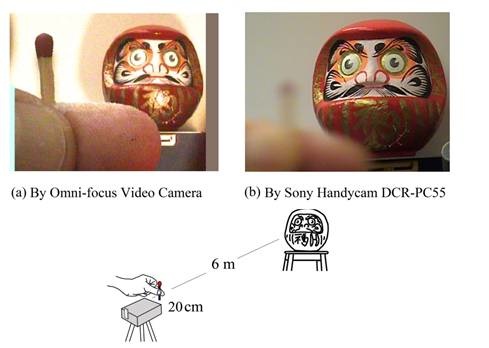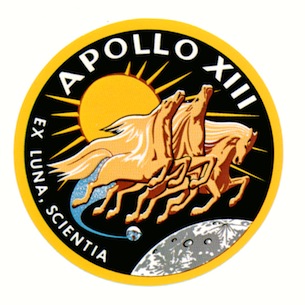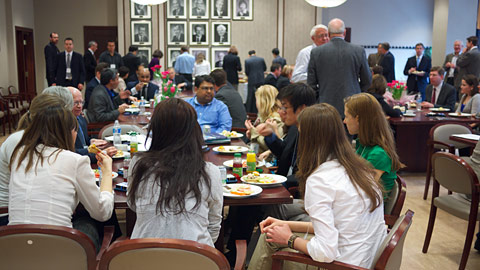Professor Chris Kennedy (CivE) published study, “Greenhouse Gas Emissions from Global Cities” examined ten global cities’ greenhouse gas emissions. Professor Kennedy believes cities can learn best practices and strategies for reducing air pollutants by comparing and understanding why different cities generate the emissions they do.
Among the findings, the Greater Toronto Area is found to produce high emissions due to its climate and transportation consumption. Click here to read the full article from NEWS @ U of T’s website.

University of Toronto, a world-leading research university, announces a breakthrough development in video camera design. The Omni-focus Video Camera, based on an entirely new distance-mapping principle, delivers automatic real-time focus of both near and far field images, simultaneously, in high resolution. This unprecedented capability can be broadly applied in industry, including manufacturing, medicine, defense, security — and for the consumer market.
Inventor and principal investigator of the Omni-focus video camera, Professor Keigo Iizuka of The Edward S. Rogers Sr. Department of Electrical and Computer Engineering, explains that, “the intensity of a point source decays with the inverse square of the distance of propagation. This variation with distance has proven to be large enough to provide depth mapping with high resolution. What’s more, by using two point sources at different locations, the distance of the object can be determined without the influence of its surface texture.” This principle led Professor Iizuka to invent a novel distance-mapping camera, the Divergence-ratio Axi-vision Camera, abbreviated “Divcam,” which is a key component of the new Omni-focus Video Camera.
The Omni-focus Video Camera is produced in collaboration with consulting investigator Dr. David Wilkes, president of Wilkes Associates, a Canadian high-tech product development company. It contains an array of color video cameras, each focused at a different distance, and an integrated Divcam. The Divcam maps distance information for every pixel in the scene in real time. A software-based pixel correspondence utility, using prior intellectual property invented by Dr. Wilkes, then uses the distance information to select individual pixels from the ensemble of outputs of the color video cameras, and generates the final “omni-focused” single-video image.
“The Omni-focus Video Camera’s unique ability to achieve simultaneous focus of all of the objects in a scene, near or far, multiple or single, without the usual physical movement of the camera’s optics, represents a true advancement that is further distinguished in terms of high-resolution, distance mapping, real-time operation, simplicity, compactness, lightweight portability and a projected low manufacturing cost,” says Dr. Wilkes.
The resulting image shown in Figure 1a (taken with a prototype using two-color video cameras) clearly demonstrates how the omni-focused output dramatically differs from that of a conventional camera, shown in Figure 1b. Note that in the omni-focused image, the fingers in the foreground are so sharply focused that even the fingerprints are easily recognized.
Figure 2 illustrates the Omni-focus Video Camera’s high pixel resolution. Although the two sewing needles were photographed approximately 1.2 meters apart, both are in sharp focus. Note the eye of the back needle, is actually viewed through the eye of the front needle.

The camera is still in the research phase. But it’s not difficult to imagine how far-reaching an impact the Omni-focus Video Camera could have on several industries. As for the future direction of his research, Professor Iizuka sees the following possibilities:
(1) Application of the Omni-focus Video Camera to TV studio cameras. Consider the example of a musical concert being televised by a major network. Even though the singer is in sharp focus, band members in the background, are invariably out of focus. Conventional video cameras are unable to focus simultaneously on both the singer and band members in the background. The Omni-focus Video Camera removes this limitation to deliver higher-quality video images and improved quality of experience to potentially millions of TV viewers, worldwide.
(2) Application of the Omni-focus Video Camera to medicine. Says Professor Iizuka, “I’d like to apply the principle of the Omni-focus Video Camera to the design of a laparoscope. It would help doctors at the operating table, if they can see the entire view without touching optics of the laparoscope, especially if dealing with a large lesion.”
Please follow the links below to read more on the applicability of this research in various industry sectors:
- Science Daily: Omni-Focus Video Camera to Revolutionize Industry: Automatic Real-Time Focus of Both Near and Far Field Images
- Popular Science: Omni-Focus Video Camera Can Focus Near and Far at the Same Time
- Security Systems News: Everything in focus, all the time
- Medical News Today Omni-Focus Video Camera To Revolutionize Industry
The composition of the Committee was announced in PDAD&C #77 last week. Since that announcement, Ms. Ines Fernandez has had to step aside from serving on the Committee. In accordance with Section 60 of the Policy on Appointment of Academic Administrators, President David Naylor has appointed a revised committee to recommend the appointment of a Dean of the Faculty:
- Prof. Cheryl Misak,
Vice-President and Provost (chair) - Prof. Susan Andrews,
Department of Civil Engineering - Prof. Craig Boutillier,
Department of Computer Science, Faculty of Arts and Science - Mr. Paul Cadario,
Senior Manager, Trust Fund Quality Assurance and Compliance, World Bank - Prof. Brian Corman,
Dean, School of Graduate Studies - Prof. Alis Ekmekci,
University of Toronto Institute for Aerospace Studies - Mr. Jason Grenier,
Graduate student, The Edward S. Rogers Sr. Department of Electrical and Computer Engineering - Ms. Claire Kennedy,
Alumna - Ms. Sandra Langlands,
Director, Gerstein Science Information Centre - Ms. Barbara McCann,
Registrar, Faculty of Applied Science and Engineering - Prof. Ali Sheikholeslami,
The Edward S. Rogers Sr. Department of Electrical and Computer Engineering - Prof. Richard Sommer,
John H. Daniels Faculty of Architecture, Landscape & Design - Ms. Sabrina Tang,
Undergraduate student, Department of Mechanical and Industrial Engineering - Prof. Steven Thorpe,
Department of Materials Science and Engineering - Mr. David Whitaik Lee,
Graduate student, Institute of Biomaterials and Biomedical Engineering - Prof. Christopher Yip,
Department of Chemical Engineering and Applied Chemistry and Institute of Biomaterials and Biomedical Engineering
The Advisory Committee for the search welcomes comments and nominations from interested persons. These should be sent to the attention of Helen Lasthiotakis, Director, Academic Programs and Policy, by May 10, 2010 by mail (Room 225, Simcoe Hall) or by email to h.lasthiotakis@utoronto.ca

A team of engineers from the University of Toronto Institute of Aerospace Studies (UTIAS) will receive the Canadian Air and Space Museum’s Pioneer award in recognition of the critical role they played in rescuing three Apollo 13 astronauts in April 1970.
This story appeared in at least 50 online publications today. Follow the links below to read the complete story:
By Carolyn Farrell
Professors Axel Guenther, Ridha Ben Mrad and Jan Spelt, of the Department of Mechanical and Industrial Engineering, have been honoured by the Canadian Society for Mechanical Engineering (CSME) for their achievements in the field. Professor Guenther is the 2010 recipient of the I. W. Smith Award, for outstanding achievement in creative mechanical engineering within 10 years of graduation. Professors Ben Mrad and Spelt were elected CSME Fellows, for excellence in mechanical engineering and significant contributions to the profession.
Axel Guenther’s research involves the study of dynamically changing microenvironemnts for applications in materials science and biomedicine. His research has already resulted in “lab-on-a-chip” materials processing technology, as well as high-throughput platforms with the potential for widespread application in biopharmecutical drug development. Professor Guenther has authored 22 refereed journal publications with over 725 citations. Previous awards include the ETH Medal from the Swiss Federal Institute of Technology and an Early Researcher Award from the Province of Ontario.
Currently the Associate Chair, Research for MIE, Ridha Ben Mrad’s research interests are in the areas of mechatronics and micro electro mechanical systems (MEMS). Professor Ben Mrad led the development of the mechatronics program at UofT, the first such program offered in Canada. He has authored approximately 100 refereed publications in top-tier journals and conferences, and has supervised the research of over 40 graduate students and postdoctoral fellows. In 2002 he received the Faculty’s Early Career Teaching Award.
Jan Spelt is internationally known for his research in the mechanics of materials and manufacturing processes. He has made significant contributions in the areas of microelectronic packaging, adhesive joints, abrasive jet micro-machining and vibratory surface finishing. Professor Spelt’s industrial partners include RIM, Celestica, Nortel, Dow Chemical and General Motors. His research has resulted in over 100 refereed journal publications and ten book chapters. In recognition of his contributions, Professor Spelt has been invited to serve on several boards and committees in his areas of expertise.
“Professors Ben Mrad, Guenther and Spelt have all made outstanding contributions to mechanical engineering in their respective fields,” said Cristina Amon, Dean, Faculty of Applied Science and Engineering. “They are most deserving of these accolades and I am delighted that CSME is honouring them for their achievements.”
The CSME Awards Ceremony will take place on June 9, 2010 at the CSME Forum Banquet in Victoria, B.C.

TORONTO, ON – With infrastructure spending a big part of government economic stimulus plans across North America, concrete is suddenly looking like a hot commodity. The University of Toronto’s Faculty of Applied Science and Engineering is at the forefront of innovation when it comes to concrete, sustainability and engineering solutions to some of the world’s most pressing issues. Now, one of our top professors has received recognition from the industry and the federal government.
R. Doug Hooton was appointed today Chairholder of the Natural Sciences and Engineering Research Council (NSERC) of Canada/ Cement Association of Canada Industrial Research Chair in Concrete Durability and Sustainability.
“Industrial Research Chairholders have to be outstanding researchers, able to build and nurture successful relationships with their industrial partners,” says Suzanne Fortier, president of NSERC. “Dr. Hooton is an excellent example of this blend of talent and skills. The Canadian cement and concrete industries will benefit greatly from his research goal to produce stronger, higher quality building materials.”
The Chair’s funding is valued at $1.8 million over five years with contributions from the University of Toronto, NSERC, the Cement Association of Canada, Holcim Canada and Whitemud Resources. The financial award will create a new tenure-track faculty position in this area and also allow for funding graduate student and research associate positions.
The goal of the Research Chair is to provide innovative and effective approaches to improve both the environmental sustainability and durability of concrete, as well as to provide leadership in development of specifications and industry standards. Enhancing the durability of concrete, while incorporating recycled local materials, improves the sustainability of buildings and infrastructure.
“This Chair will help focus research and teaching in an area that is critical to making informed choices in infrastructure renewal and addressing the environmental and energy sustainability challenges facing the cement, concrete and construction industries,” said Dr. Hooton. “This area is of utmost importance to the Canadian cement industry and to Canadian industry and infrastructure as a whole, and I want to thank NSERC and the industrial partners for their commitment, even in tough economic times.”

Some of Professor Hooton’s discoveries in the chemical degradation of concrete by alkali-silica reaction and in the rate of penetration of de-icing salts leading to corrosion of steel in concrete bridges have been adopted by the Ontario Ministry of Transportation as well as in Canadian (CSA) and US (ASTM) standards. He is also using sophisticated nanotechnology level tools to examine the chemistry and mineralogy of concrete and to investigate its durability. He also hopes to use ‘particle packing’ down to the nano level to make what he calls “quantum leaps” in the properties and durability of concrete.
“Professor Hooton is a leading innovator in the important field of sustainable concrete engineering and cement research,” said Cristina Amon, Dean, Faculty of Applied Science and Engineering. “We are grateful to NSERC and our industrial partners for enhancing our efforts to address concrete sustainability and its environmental implications in the infrastructure renewal.”
Readers may also be interested in a recent article published on May 11, 2010 in the Daily Commercial News and Construction Record titled, University of Toronto professor awarded concrete-research chair.
